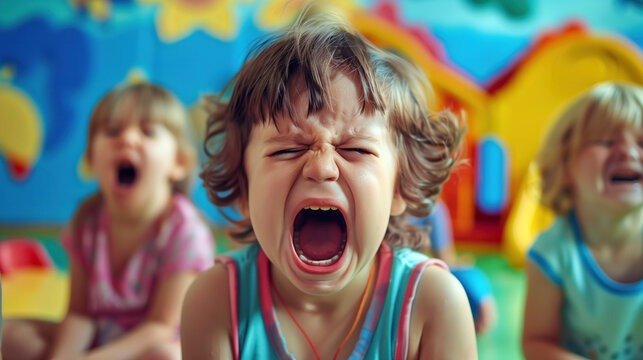7 Common Reasons Kids Cry That Aren’t Always Easy to Recognize

Source:
As children grow older, their reasons for crying become more complex, often related to stress, tiredness, or other emotional challenges. For instance, a parent recounted a frustrating morning when their child cried about the fit of her leggings, highlighting how such moments can feel overwhelming. According to Dr. Diana Divecha, a child’s tears always communicate a need for help in regulating emotions, regardless of whether the reasons seem logical to adults.
Here are 7 Common Reasons Kids Cry That Aren’t Always Easy to Recognize:
Your Child Is Overtired: When children are overtired, their bodies release extra adrenaline and cortisol, hormones associated with stress, making them more susceptible to irritability and tears. This is compounded by the fact that their brains are still developing, which affects impulse control and emotional regulation. When tears are due to tiredness, experts advise getting them to bed quickly rather than trying to negotiate. If this becomes a frequent issue, it may be necessary to reassess sleep priorities, such as limiting screen time at night or allowing more wind-down time.
Your Child Is Overwhelmed: Research indicates that around 20% of people have sensory processing sensitivity (SPS), making them more reactive to stimuli like sounds and lights. Children with SPS may become easily overwhelmed in noisy environments, leading to tears. This sensitivity is a natural variation in biology and personality, not a disorder. It’s important to recognize that crying can be beneficial; instead of trying to stop the tears, parents should support their child by acknowledging their feelings and offering reassurance, such as saying, “That was hard. You’re really upset. I’m right here. I can help you.”
Your Child Is in Pain: Babies express pain with loud, intense cries and fewer breaths, while fussy cries are lower-pitched and irregular. By ages 3 to 4, children can cry in anticipation of pain, understanding that certain actions, like getting a shot, may hurt. To comfort a child in pain, physical touch or hugs can trigger oxytocin, a natural pain reliever, and using an ice pack can help reduce swelling.
For children afraid of future pain, start with empathy by acknowledging their feelings, then shift to distraction techniques during stressful situations, like pretending fingers are birthday candles. If at home, explain what to expect step-by-step and plan a fun activity afterward, such as a trip to the park, to give them something positive to look forward to.
Your Child Is Hungry: Hunger is a common reason for older kids to cry, similar to adults becoming “hangry.” Children typically need to eat every three to four hours, which includes three meals and two snacks, to maintain their energy and emotional regulation. If you have a hunger-sensitive child, it’s helpful to pack snacks and provide quick, healthy options when they get cranky, such as baby carrots or apple slices, without offering too many choices.
Around age 3, children also start to feel remorse and may cry when they’ve hurt someone or made a mistake. This reaction can be linked to their developing empathy and fear of losing love. It’s important to guide them in making amends, encouraging them to think of ways to help those they’ve upset, such as rebuilding a sibling’s toy or expressing an apology.
Your Child Is Scared: Fear is a normal and healthy emotion that serves a survival function. Infants and toddlers may cry when overwhelmed by their senses, reacting to sudden or unexpected stimuli like a darting pet or a loud noise. As children grow, their imagination develops, leading them to fear things that previously didn’t bother them, such as animals or darkness.
When addressing their fears, it’s important to empathize, even if their fears seem unreasonable. Acknowledging their feelings can help them calm down. For instance, you can validate their fear by saying, “That seems so scary for you,” and then encourage them by expressing confidence in their strength to face the situation.
Your Child Is Mad:
Frustration often leads to tears in toddlers and preschoolers, who have limited emotional control. Their outbursts like stomping or yelling can result from feeling that something is unfair or not getting what they want. Since their brains are still developing the ability to be flexible, these reactions are impulsive rather than intentional. To help them cope, acknowledge their feelings with empathy. For instance, you might say, “You’re really mad because you wanted to wear your sandals even though it’s cold.” This validation can help soothe their emotions and reduce their tears.
How To Keep Your Cool During a Tantrum
When your child is upset, staying calm is crucial, as your stress can escalate the situation. Avoid minimizing their feelings, as this can invalidate their emotions and hinder their ability to manage them in the future. Instead, remind yourself that they are just a child, and consider using strategies to help de-escalate the situation effectively.
Pause: Take a 30-second break when you’re getting upset, says Dr. Divecha. “In that moment between getting trigged and choosing a response, think of your best parenting self and how you might channel that now.”
Picture yourself swaying in a storm: A kid’s tantrum can feel disorienting, but it will pass. “Visualize a storm blowing through. You’re just sitting on the sidelines, calm and nonjudgmental, but waiting,” says Dr. Divecha. In other words, don’t let the wind toss you around.
Breathe: To help calm down, practice paced breathing by inhaling for four seconds and exhaling for six. This technique triggers your relaxation response and can be a powerful way to manage emotions. It’s beneficial to show your child this method, as it demonstrates that everyone experiences strong emotions and provides them with a healthy coping strategy.
Put your hand over your heart: Any touch, even your own, releases the soothing hormone oxytocin, explains clinical psychologist Dr. Huebner. This simple self-care gesture can help center you to feel more present.
How To Quiet Their Tears
Listen first, then fix: Don’t rush this part. Hear your child’s story and wait until you see their face or posture soften—a sign that they’re ready to hear your advice or explanation. “Adults tend to skip over the emotions quickly in order to find a solution, but kids aren’t able to listen until they feel fully heard,” says Dr. Kennedy-Moore.
Make some room: Some kids like to be held, but others need their space. “It’s a way for your child to learn how to calm themselves down,” says Dr. Anderson. Without making your kid feel they’re being banished for crying, ask if they want a cozy “nest” on the couch with books and a blanket or if they’d prefer peace and quiet alone in their bedroom.
Grab an ice pack: Splashing cold water or putting something chilled on your child’s forehead, eyes, or cheeks can help them snap out of an especially intense emotional spiral. The cold feeling triggers the “dive response” that automatically slows down breathing, calms the body, and, in turn, brings down their emotional temperature.8 Just be sure to ask your child first before doing this.
Get wild: For kids who cry often, tears may represent letting go of tension and built-up energy. “Laughter is equally effective, so build roughhousing, dancing, or chasing each other around the house into your daily routine,” says Dr. Huebner. “It’s like releasing a pressure valve.”
In conclusion, As children grow, their emotional world becomes more complex, leading to varied reasons for their crying, such as exhaustion or hunger. It’s important for parents to remain calm during these moments. If there are concerns about a child’s emotional or mental health, consulting with their doctor is advisable.
Read More: https://childreninfobank.com/safebank/7-common-reasons-kids-cry-that-arent-always-easy-to-recognize/
Image Source: https://www.parents.com/





